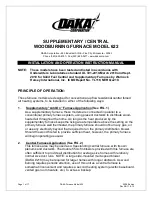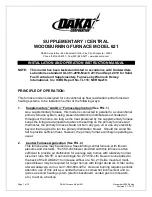
10
4. Install the duct connector back in the floor opening with
the bottom tabs extending into the supply air duct.
5. Install the optional mounting plate under the back side
of the duct connector as shown in
. Align the
screw holes in both components.
6. Secure the duct connector and the mounting plate to
the wood floor with appropriate size screws.
7. Bend the connector tabs on the bottom of the duct
connector upwards and as tight as possible against
the supply air duct.
8. Bend both tabs up 90° on the mounting plate. See
9. Seal all connections with industrial grade sealing tape or
liquid sealant. See HUD Code 3280.715 for acceptable
standards for tape and sealants.
NOTE:
Requirements for sealing ductwork vary
from region to region. Consult with local codes for
requirements specific to your area.
Alternate Attachment Method
The standard duct connector is designed for use on ducts
12” in width. However if there is insufficient clearance to
bend the duct connector tabs, this alternate attachment
method may be used.
1. Score and cut the top of the supply air duct as indicated
NOTE:
If Option 1 is selected, cut out the metal from
the shaded area.
2. Fold the two flaps (Options 1 or 2) up to form the opening
for the duct connector.
3. Install the duct connector with the bottom tabs extending
into the supply air duct.
4. Bend the tabs on the bottom of the duct connector
upwards and as tight as possible against the supply
5. Form the flaps (Options 1 or 2) up against the duct
connector as tight as possible.
6. Secure the duct connector flaps to the supply air duct
with staples (3 minimum) or if a 2x block/joist is not
provided, use sheet metal screws (2 minimum).
NOTE:
The duct connector tabs may be attached to
the air duct with sheet metal screws or other suitable
fasteners as long as the duct connector and the air duct
are securely attached.
7. Seal all connections with industrial grade sealing tape
or liquid sealant.
NOTE:
Requirements for sealing ductwork vary
from region to region. Consult with local codes for
requirements specific to your area.
Round Duct Connector Installation
1. Apply a bead of caulking, mastic, or other approved
sealant around bottom side of connector.
2. Install and center the duct connector in the floor opening.
3. Install the mounting plate under the back side of the
duct connector. See
NOTE:
Align the screw holes in both components.
4. Secure the duct connector and the mounting plate to
the wood floor with appropriate size screws.
5. Connect the round supply duct to the underside of the
duct connector and secure them with field supplied
sheet metal screws.
6. Seal all connections with industrial grade sealing tape
or liquid sealant.
NOTE:
Requirements for sealing ductwork vary
from region to region. Consult with local codes for
requirements specific to your area.
Installing the Furnace
Sides and back of the furnace may be enclosed by wall
framing such as in a closet or alcove. The dimensions
of the room or alcove must be able to accommodate the
overall size of the furnace shown in
and the installation clearances outlined on
page 6
. The
furnace shall be appropriately connected to the supply
distribution system as shown in
&
1. Remove furnace outer door(s) and bottom fuel line
knockout.
2. Place furnace onto duct connector and center with floor
opening.
3. Slide onto mounting plate. (Bottom rear slots on furnace
should engage with mounting plate tabs.)
4. Secure front with one (1) fastener at each corner. See
NOTE:
Additional fasteners may be used at rear, sides
or through door frame, as desired, to secure furnace to
closet or alcove framing.
ROOF JACK INSTALLATION
Required ceiling and roof cut-out openings must be
carefully located to avoid misalignment of the furnace
and Roof Jack.
NOTE:
Install only roof jack assemblies
Roof Jack Selection
1. Determine depth of ceiling cavity from center of roof
opening to center of ceiling opening noted as “Dimension
A” in
2. Determine ceiling height and subtract height of furnace
3. Add dimensions “A” & “B” (and X from
if slant deck flashing is used). The total length of
[A] + [B] + [X] must be within the minimum and maximum
range of the roof jack listed in
Application Notes
• FAW, FAWT, SAW and SAWT series roof jacks with a
5” diameter inner vent pipe may be used with all models
of MG1 Series gas furnaces.
F = Flat Flashing: flexes from 0/12 to 1/12 roof slope.
S = Slant Flashing: 2.5/12 Slope flexes from 1/12 to
4/12 roof slope, 4/12 flexes from 3/12 to 5/12.
• MG1 furnaces may be used with roof jack systems and
extension accessories as tall as 170” (except MG1-056
models, which are limited to 120”). An internal roof jack
extension (p/n 901935 - 10”, p/n 903107 - 18”) can be
used to increase roof jack height. All connections inside
the home must be made below the ceiling.
• This furnace must never be connected to a chimney
flue servicing a fireplace or other appliance designed
to burn solid fuel.
Summary of Contents for MG1 Series
Page 31: ...31...











































